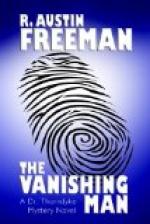“From the facts as stated in the newspaper reports it is obvious that there were four possible explanations of the disappearance.
“1. The man might be alive and in hiding. This was highly improbable, for the reasons that were stated by Mr. Loram at the late hearing of the application, and for a further reason that I shall mention presently.
“2. He might have died by accident or disease, and his body failed to be identified. This was even more improbable, seeing that he carried on his person abundant means of identification, including visiting cards.
“3. He might have been murdered by some stranger for the sake of his portable property. This was highly improbable for the same reason: his body could hardly have failed to be identified.
“These three explanations are what we may call the outside explanations. They touched none of the parties mentioned; they were all obviously improbable on general grounds; and to all of them there was one conclusive answer—the scarab which was found in Godfrey Bellingham’s garden. Hence I put them aside and gave my attention to the fourth explanation. This was that the missing man had been made away with by one of the parties mentioned in the report. But, since the reports mentioned three parties, it was evident that there was a choice of three hypotheses, namely:
“(a) That John Bellingham had been made away with by Hurst; or (b) by the Bellinghams; or (c) by Mr. Jellicoe.
“Now, I have constantly impressed on my pupils that the indispensable question that must be asked at the outset of such an inquiry as this is, ’When was the missing person last undoubtedly seen or known to be alive?’ That is the question that I asked myself after reading the newspaper report; and the answer was, that he was last certainly seen alive on the fourteenth of October, nineteen hundred and two, at 141 Queen Square, Bloomsbury. Of the fact that he was alive at that time and place there could be no doubt whatever; for he was seen at the same moment by two persons, both of whom were intimately acquainted with him, and one of whom, Doctor Norbury, was apparently a disinterested witness. After that date he was never seen, alive or dead, by any person who knew him and was able to identify him. It was stated that he had been seen on the twenty-third of November following by the housemaid of Mr. Hurst; but as this person was unacquainted with him, it was uncertain whether the person whom she saw was or was not John Bellingham.
“Hence the disappearance dated, not from the twenty-third of November, as everyone seems to have assumed, but from the fourteenth of October; and the question was not, ’What became of John Bellingham after he entered Mr. Hurst’s house?’ but, ’What became of him after his interview in Queen Square?’
“But as soon as I had decided that that interview must form the real starting-point of the inquiry, a most striking set of circumstances came into view. It became obvious that if Mr. Jellicoe had had any reason for wishing to make away with John Bellingham, he had such an opportunity as seldom falls to the lot of an intending murderer.




